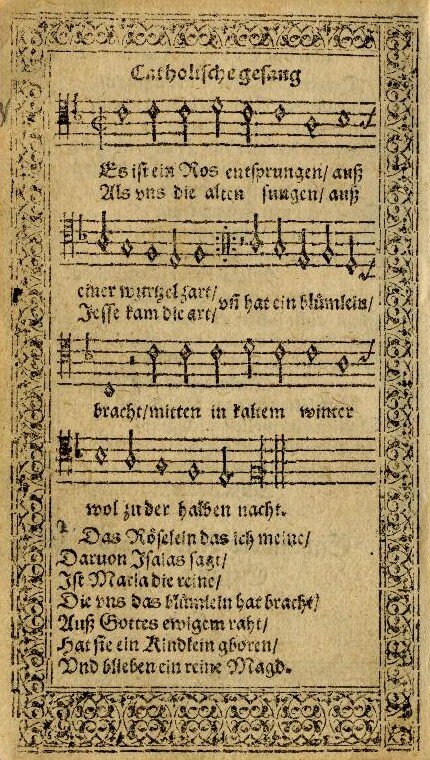The Rose and the Lamb.
Lo, How a Rose E’er Blooming (Es ist ein Ros entsprungen) is one of the best-known of numerous German carols to be adopted whole heartedly by the English-speaking world. The music first appeared in print in the Speyer Hymnbook 1599, and is most commonly sung in the version harmonized by the German composer Michael Praetorius in 1609.
The text has been in use since the 15th century. Based upon Isaiah 11:1, “And there shall come forth a rod out of the stem of Jesse, and a Branch shall grow out of his roots,” it depicts Mary as a rose sprouting from the stem of the Tree of Jesse, a symbolic device that indicates the descent of Jesus from Jesse of Bethlehem, the father of King David. Unlike other German chorales of this period, which were compiled and intended for Protestant worship subsequent to the Lutheran Reformation (1517), this hymn has enjoyed popularity among both Roman Catholics and Protestants.
In the version of the carol which Chorale will sing, Swedish composer Jan Sandström (b.1954) utilizes Praetorius’s four-part chorale setting (sung in its entirety by choir I) as a slow moving cantus firmus, within a freely composed eight-part accompaniment (choir II, humming or singing on a neutral syllable). The overall effect is that of an “acoustic halo”(Stefan Schmöe), a “timeless, atmospheric, dream-like soundscape of poignantly dissonant polyphonic strands “(John Miller). Effectively, Sandström builds a shimmering, acoustically lively performance space to house Praetorius’s jewel of a piece.
Another jewel on Chorale’s Christmas program is the 1982 setting by John Tavener (1944-2013) 1982 of The Lamb, the third poem in William Blake’s Songs of Innocence, first published in 1789. The words are:
Little lamb, who made thee
Dost thou know who made thee,
Gave thee life, and bid thee feed
By the stream and o’er the mead;
Gave thee clothing of delight,
Softest clothing, woolly, bright;
Gave thee such a tender voice,
Making all the vales rejoice?
Little lamb, who made thee?
Dost thou know who made thee?
Little lamb, I’ll tell thee;
Little lamb, I’ll tell thee:
He is called by thy name,
For He calls Himself a Lamb.
He is meek, and He is mild,
He became a little child.
I a child, and thou a lamb,
We are called by His name.
Little lamb, God bless thee!
Little lamb, God bless thee!
The lamb in the poem symbolizes Jesus Christ as identified by John the Baptist in John 1:29, “Behold the Lamb of God who takes away the sin of the world.” Though not specifically an Advent or Christmas text, Blake’s poem invokes the image of the little child, Jesus, as well as the animals around the manger, and this setting is usually sung at Christmas. Tavener’s music-- simple, poignant, somewhat melancholy—presents both the innocence and joy of the scene, and the tragic loss of that joy and innocence in Blake’s companion volume, Songs of Experience, which inevitably lurks in the background.


